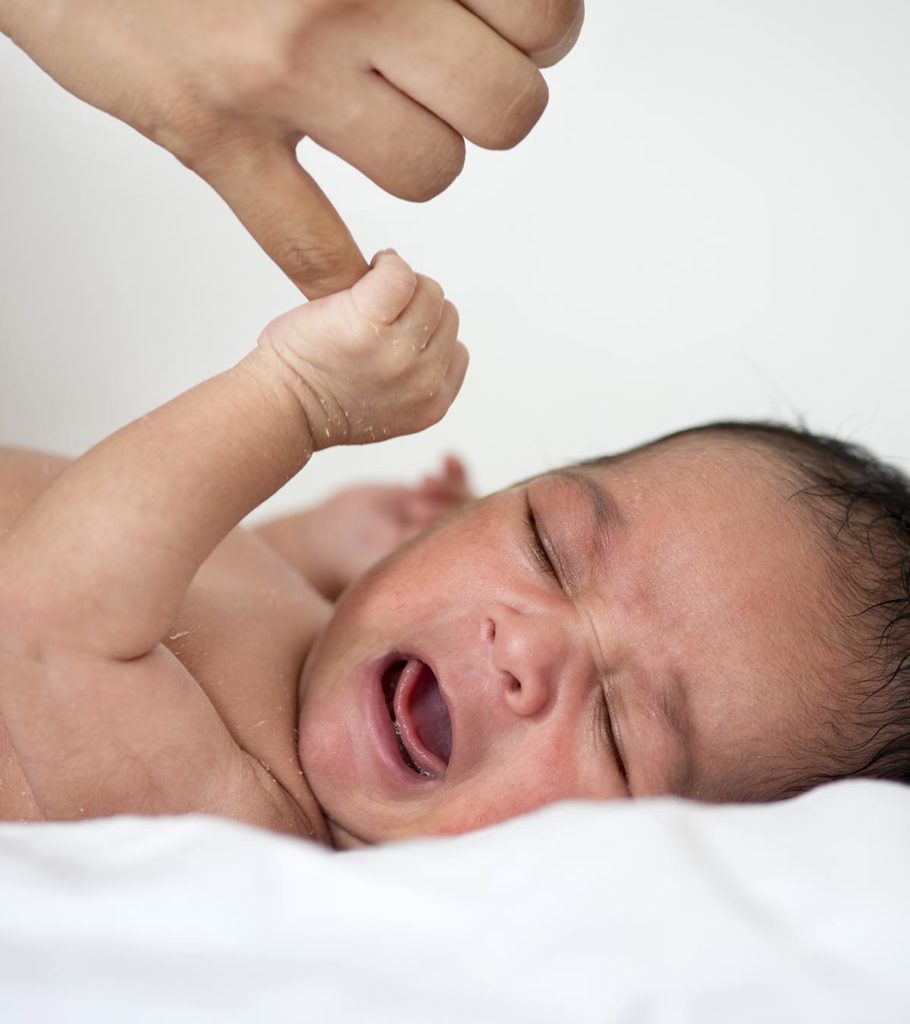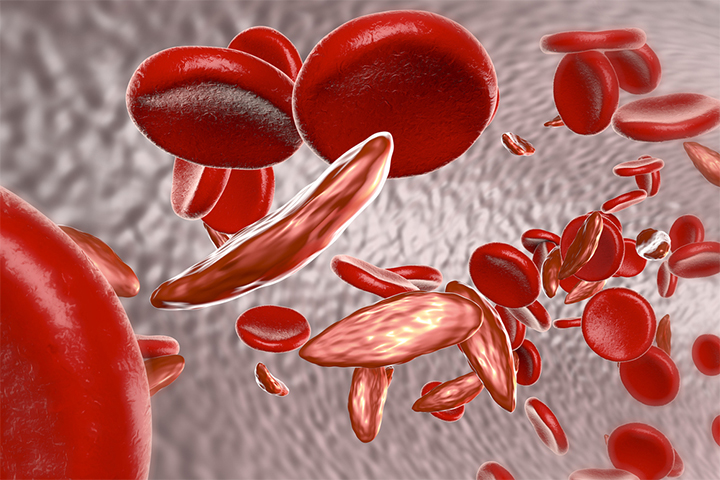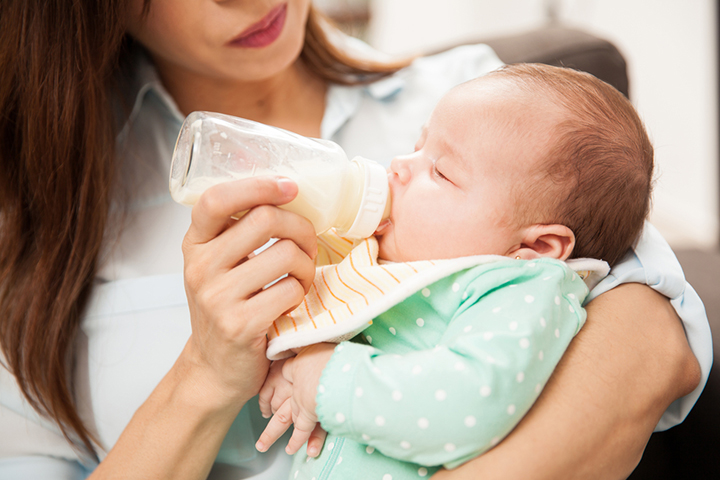According to the World Health Organization (WHO), iron deficiency anemia in babies is widespread worldwide (1) and mostly affects babies aged nine to 24 months. Just as in adults, iron deficiency anemia (IDA) is defined as an acute low concentration of red blood cells in newborns. Read this post to know the causes and symptoms of IDA in newborns, as well as how to prevent it.
What Is Anemia And What Causes It In Babies?
Anemia is the condition where the infant’s body does not produce enough red blood cells (RBCs), leading to poor circulation of oxygen in the body. The body does not grow healthily and fails to achieve developmental milestones due to the malfunctioning of the oxygen-deprived cells. According to the WHO, approximately 39.8% of children aged between 6 and 59 months worldwide were affected by anemia in 2019.
Causes of anemia in infants are
- Destruction of red blood cells: Genetic disorders such as sickle cell disease make the immune system destroy healthy blood cells, bringing down the RBC count, and thus the level of oxygen transport is reduced. Excessive RBC loss prevents the count from being replenished thus leading to anemia. This is called hemolyticiXDestruction of red blood cells. anemia.
- Loss of RBCs: Blood loss from a wound or an internal bleeding due to an injury leads to the loss of RBCs. Frequent nose bleeding or inflammatory bowel disease with bloody diarrhea also causes the loss of RBCs.
- Low production of RBCs: The bone marrow does not produce enough red blood cells to meet the oxygen demands of the body cells, due to a condition called aplasticiXFailure of tissue or organ to develop or function properly. anemia. This could be due to the side effects of medication, viral or bacterial infections, or certain forms of cancers like blood or bone. However, iron deficiency anemia (IDA) is the leading cause of aplastic anemia in babies.
There are several kinds of anemia ranging from genetically-caused anemia to the one due to nutrient deficiency. Overall there are almost ten types of anemia. In this post, we focus on iron deficiency anemia in babies.
What Is Iron Deficiency Anemia?
Iron deficiency anemia occurs when the baby has insufficient dietary iron intake, leading to an inadequate formation of hemoglobin protein. The protein contains iron atoms, which bind to oxygen in the lungs and carry it to different body cells. Poor levels of the protein slow the production of RBCs causing iron deficiency anemia, which is the leading cause of babies and older infants.
What Causes Iron Deficiency In Babies?
Following are the reasons for iron deficiency in babies:
- Inadequate intake of dietary iron: Your baby will get all the iron he needs from breastmilk until six months, after which you must introduce iron-rich foods since breastmilk will not be sufficient. Babies who are fussy eaters, are not provided iron-rich/iron-fortified food, or continue to be fed exclusively on breastmilk tend to develop anemia.
- Introducing cow’s milk before 12 months: Babies introduced to cow’s milk before the age of 12 months can develop anemia even on consuming iron through other food sources. This is because cow’s milk is a poor source of iron making it hard for the body to absorb iron from other sources.
- Premature birth: Preterm/premature infants are at the greatest risk of anemia as they do not have adequate iron reserves in their bodies at birth. About 85% of preterm babies below 1,500gm may develop anemia.
- Babies born to diabetic mothers: Women with poorly managed diabetes are at a greater risk of giving birth to anemic babies. A study found that about 65% of diabetic mothers had low fetal iron levels and of them about 25% had severe iron deficiency and barely passed on any iron to the baby (2).
- Low birth weight: Maternal hemoglobin levels play a significant role in determining low birth weight anemia (3) if the mother has been anemic during the third trimester (4).
What Are The Symptoms Of Iron Deficiency In Babies?
It is crucial to discern the signs of anemia in babies before they adversely impact the baby’s health.
- Pale skin: The skin loses its color and texture, and appears dull and pale, predominant around the eyelids and hands.
- Weakness: Constant tiredness with acute drowsiness and lack of interest in activities.
- Irritability: Infants may constantly be irritated, and older infants may throw tantrums.
- Disinterest in food and low appetite: The little one eats less than normal or may not eat at all. It results in low dietary intake.
- Trouble breathing: Anemic babies may not be able to breathe efficiently and suffer from frequent shortness of breath.
- Faster heart rate: The heart beats faster to compensate for poor oxygen levels, leading to a rapid heart rate.
- Swelling in limbs: Some babies may have swollen limbs, hands and feet.
- Pica: Pica is a condition in which a baby craves and eats non-food items such as chalk, dust, etc. It is a crucial indicator of nutrient deficiency.
- Poor height, weight, and head circumference: Since the body is low on hemoglobin, cells do not get sufficient oxygen for growth and development, and the baby has a reduced height, weight, and head circumference gain.
The moment you notice any of these signs and suspect anemia, take your baby to a doctor for an affirmative diagnosis.
How Is Iron Deficiency Anemia In Babies Diagnosed?
Anemia in babies can be detected through any of the following medical tests:
- Red blood cell tests: A drop of blood is observed under a microscope. A low count and small size of the RBCs indicate anemia. Types of RBCs (young and old) are counted to determine if their production is normal. A hematocritiXPercentage by volume of red blood cells in the blood. test is also conducted to determine the percentage of blood plasma (5). The doctor may also take a stool test to check for microscopic loss of RBCs in the baby’s stool.
- Iron tests: A sample of the baby’s blood is tested for hemoglobin and iron and its compound levels. Ferritin (protein that stores iron) tests are also conducted (6). Blood may be screened for genetic diseases such as sickle cell, which brings down the total iron binding capability of RBCs.
If the test is positive for anemia, the doctor lists out the treatment options.
How Is Iron Deficiency Anemia Treated In Babies?
IDA is treated by replenishing the deficit of iron in the body.
- Iron supplements: The doctor will prescribe baby-safe iron supplements as per the infant’s age and severity of anemia. The supplements contain vitamins, especially C, as it facilitates the absorption of iron.
If the supplement is a powder, you can mix it with baby food such as purees, while Syrups can be given directly. It can take the infant three to six months of treatment to regain normal iron levels.
- Iron-rich food and supplements: A pediatric dietician chalks down an iron-rich diet plan to replenish low iron reserves in the baby’s body. You may be given a feeding schedule, which you need to continue throughout the course of treatment.
Your baby will appear healthy within weeks of the treatment. It is important to complete the treatment as untreated anemia can lead to critical health problems in babies.
Long Term Effects Of Iron Deficiency Anemia
If IDA is left untreated, the baby can develop the following:
- Slow gain in developmental milestones: Anemia affects the pace at which a baby achieves developmental milestones, meaning that even though he grows normally, he would achieve the milestones later.
- Physical and mental retardation: The insufficiency of iron causes regression in the functions of the brain and other body parts such as the skeletal muscles. For instance, infants with anemia may develop lower intelligence quotient (IQ) and have retarded motor development. Research shows that older infants with chronic iron deficiency develop behavioral problems and have trouble socializing.
- Impaired immunity: Iron helps in maintaining the ideal count of lymphocytes that play a crucial role in defending the body against pathogensiXA microorganism (virus, bacteria, etc.) capable of causing a disease. . Iron is also essential for normal development of the immune system. Research has shown a drop in immunity levels in infants that suffer from iron deficiency anemia (7). A sustained low immunity makes the baby prone to infections and diseases.
As iron deficiency anemia can have a lasting adverse impact on the baby, you need to take measures to prevent the problem. Fortunately, prevention of IDA is not difficult.
How To Prevent Iron Deficiency Anemia In Babies?
Preventing iron deficiency is simple. All you need to do is ensure that the baby is getting the recommended dietary allowance (RDA) of iron depending on the age.
Recommended dietary allowance (RDA) of iron in babies (8):
| Age | Daily dietary iron requirement |
|---|---|
| 0-6 months | 0.27mg |
| 7-12 months | 11mg |
Note: Babies should not have more than 40mg of iron per day until the age of 12 months.
The diet for preventing iron deficiency will depend on the infant’s age.
1. Infants younger than six months:
Babies are born with reserves of cellular iron, which last in the bloodstream for six months, while the additional iron requirement is met through breastmilk. The average iron content of breastmilk is 0.35mg per liter, and an average infant has 780ml of breastmilk every day (9). This quantity meets the daily requirement of iron.
The iron content in the breast milk depletes in four months, especially if the babies have low birth weight or the mothers are diabetic. Such a situation can lead to anemia in newborns.
To cure this, the American Academy of Pediatrics recommends an iron supplement of 1mg/kg of the baby’s day per day. However, check with your doctor to get a better understanding.
Babies who are formula-fed for six months should have 0.27mg of iron per day. Most iron-fortified infant formulas have 12mg of iron per liter of formula milk. The iron’s bioavailability, which is the actual amount of iron absorbed by the body, from infant formula is less than breastmilk, which explains the higher concentration of iron in formulas. Nevertheless, The American Academy of Pediatrics says that 12mg of iron per liter of formula is safe for babies.
2. Infants older than six months:
An infant older than six months has wider choices for iron intake as he has solid food. Meat is the best source of iron since it is rich in heme iron, which is readily absorbed by the body. You can combine meat with an iron-rich vegetable such as beans for maximum iron absorption. Iron-fortified cereal for babies may be a good source of nutrition, especially for vegetarians, as it contains 18mg of iron. Cereals may also contain added vitamins such as C, which helps in the absorption of nonheme ironiXIron found in plant foods such as legumes, grains, seeds, leafy greens, and nuts. .
If you intend to give formula as a supplemental food, then make sure you balance the quantity with other iron-rich foods.
3. Premature infants:
Breastmilk is not sufficient for preterm infants, and they need daily iron supplements of 2mg/kg per day until 12 months. Preterm infants can also be given higher concentration of iron at 14.6mg per liter. All iron-related nutrition in premature babies should be decided by a medical professional.
Iron deficiency anemia in babies is a common occurrence that could be caused by decreased production or destruction of RBCs. It may also be due to other factors such as inadequate or improper intake of dietary iron. Since this condition can be treated by replenishing the body’s iron stores, you need not worry much upon the diagnosis of anemia. If you notice any symptoms of iron deficiency in babies, report the signs to a pediatrician and administer the supplements as suggested. You may even seek nutritional counseling if you are unsure about what foods to feed your baby. Also, indulge your children in healthy eating practices to prevent IDA and malnutrition.
Key Pointers
- Anemia is characterized by a lack of healthy RBCs caused by destruction, loss, and low production of RBCs.
- Inadequate dietary iron intake, premature birth, diabetic mothers, low birth weight, and consuming cow’s milk before turning one increase the risk of iron deficiency in babies.
- Symptoms of iron deficiency in babies include pale appearance, fatigue, irritability, breathing difficulties, lack of appetite, pica, and delayed physical growth.
- Blood tests are conducted to diagnose iron deficiency by analyzing RBC morphology, hemoglobin, and iron levels.
- Age-appropriate iron supplementation may be prescribed by doctors to treat anemia in babies by modifying their diet.
Iron deficiency is dangerous for children because it causes fatigue, difficulty concentrating, and a weakened immune system. Watch this helpful video to learn more about this issue.















